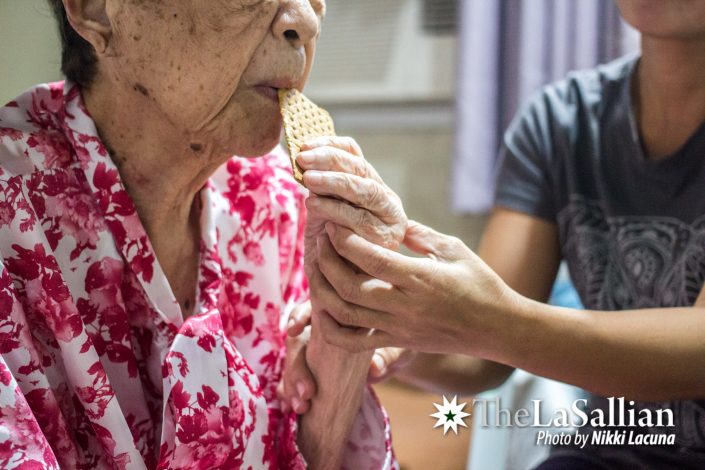Nestled under the shade of an ageless tree stands Iloilo City’s first-ever home care facility for patients with neurological disorders—Balay Aruga. At a glance, one might mistake it for a typical suburban home; it features a well-kept garden and a friendly pet dog, while situated at its center is a humble structure with walls decorated with the occasional wooden motif common among modern Ilonggo suburban homes.
A relaxed atmosphere—one that can seem unfamiliar to people used to the bustling city life—encompasses the whole facade, providing comfort to visitors and residents alike. One might expect to find a family residing in Balay Aruga; instead nurses, caregivers, a physical therapist, and the occasional visiting doctor can be found gathered around a big dining table, spending time with the elderly patients that they care for.

Providing aruga
Established on July 28, 2017 in Arevalo, Iloilo City as a home for those in need, Balay Aruga is an in-between home for neuro-patients undergoing recovery procedures. The residents of this home consist mostly of the elderly who recently had an operation or are suffering from neurological disorders, manifesting as a transition place from hospital to home care.
Seeking to help neuro-patients with their rehabilitation through physical therapy and other methods, the facility serves to provide all this through its friendly, home-like atmosphere. Balay Aruga—which translates to “home care” in Hiligaynon, Iloilo’s local language—is a place where patients are treated like family.
“I’ve been working here since day one,” shares Jenice Basalo, a registered nurse and the house manager of Balay Aruga, as she cleans up the remaining Christmas decorations from the previous year. Unlike her fellow workers, Basalo stays within the facility for virtually the whole day—every day of the year.
Alongside Basalo are several other staff who, while not being able to commit all 24 hours of the day to the center, are equally dedicated to caring deeply for and being of service to the patients. Resident physical therapist Janice Busil usually tries to keep her schedule flexible, allowing her to make adjustments to better cater to her patients’ needs and circumstances. As she explains in Hiligaynon, “If the patient’s family would tell me that their budget can only last them for five days, then I would try my best to maximize that timeframe. Even if it’s Sunday, I would stay here just for that patient.”
Firm kindness
Properly administering care to the patients is a herculean task in its own right. Though they try their best, sometimes the staff can get frustrated in trying to care for the patients. “You will always have to deal with the patients’ impatience and tantrums. It’s like you’re dealing with a two-year old kid,” relates Basalo, as she recounts an incident where a patient insistently wanted to eat chao fan dry, despite the fact that he was still recovering from a trachea operation.
“If you can swallow this glass of water, then I will blend the chao fan so you can eat it,” Basalo had calmly said in Hiligaynon as the patient’s tantrum became too much for the other staff to handle. When the patient slammed his fist in protest, Basalo proceeded to carefully explain, “No, I’m your nurse and I will be the one to spoon feed you and to check whether you are capable of swallowing it or not.”
In the end, after helping the patient understand that his stubbornness would only aggravate his condition, Basalo was able to convince the patient that he was not yet well enough to consume chao fan.
Throughout all this, Basalo admits she struggled to keep her composure at the time, but she kept in mind the importance of firm kindness when dealing with these types of situations. “You have to at least try to put yourself in their shoes and understand their context,” she explains, emphasizing the significance of remaining calm and showing empathy no matter the situation.
A glimmer of compassion
As can be seen, caring for neuro-patients entails more than just guiding them to accomplish their rehabilitation exercises and giving them their medications. Empathy is one necessary characteristic to make the recovery process more bearable, as demonstrated in the staff’s patience and sincerity in interacting with the patients.
“The staff would even dance with the patients just to entertain them when they are bored,” Basalo adds. “We [playfully and affectionately] tease them—just like a family would.”
“Come on, Mommy. Dance!” Basalo would encourage; she recalls how a smile would slowly form on her elderly patient Bernadita Ferraris’ face whenever her favorite songs would be played. “I would play videos from YouTube where she can see her son singing…I do that almost every day and night,” Basalo conveys, sharing that they would sway to the music of South Border—Brix Ferraris, the patient’s son, being the former lead vocalist of the band.
Just like their graceful dancing, the staff’s selfless compassion flows not just through the harmonious relationships that they build with the patients, but also through the zealous service that they tirelessly provide.
“Maybe this is my mission,” expresses Basalo in Hiligaynon, explaining that she missed the opportunity to provide the same level of care she gives her patients now to her parents when they had become senile. “If I wasn’t able to do the same thing for my parents, hopefully I’ll be able to help others who went through the same thing they did.”
The passion that individuals like Basalo and Busil have shown ultimately translates to love for their work and love for their patients. Truly, Balay Aruga exemplifies how medical care is necessary and can work across all settings—whether it’s in a hospital, at home, or something in between.

2 replies on “Balay Aruga: A home far from home”
Thank you guys for featuring us on your paper ? stay safe ?
Wow! Thank you! ?